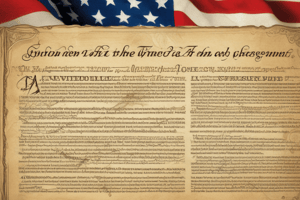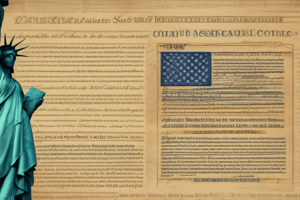Podcast
Questions and Answers
Which event highlighted the weaknesses of the Articles of Confederation?
Which event highlighted the weaknesses of the Articles of Confederation?
- The Trail of Tears
- Shays' Rebellion (correct)
- The French and Indian War
- The War of 1812
What was the primary purpose of the Bill of Rights?
What was the primary purpose of the Bill of Rights?
- To protect individual liberties (correct)
- To specify the powers of Congress
- To outline the structure of government
- To list the grievances against the king
Who was the key author of the Declaration of Independence?
Who was the key author of the Declaration of Independence?
- James Madison
- Thomas Jefferson (correct)
- George Washington
- Benjamin Franklin
What is a significant outcome of the Federalist Papers?
What is a significant outcome of the Federalist Papers?
Which compromise involved determining how slaves would be counted for representation?
Which compromise involved determining how slaves would be counted for representation?
Flashcards
Bill of Rights
Bill of Rights
A series of 10 amendments added to the US Constitution, guaranteeing basic rights and freedoms for citizens. These rights protect individuals from government overreach and ensure personal liberties.
The Preamble
The Preamble
Founding document of the United States that lists the essential goals and principles of the government and the rights of the people. It serves as a framework for a more perfect Union and outlines the purpose and powers of the government.
Issues leading to the Civil War
Issues leading to the Civil War
The major issues that sparked the Civil War included slavery, states' rights and economic differences, the expansion of slavery into new territories, and differing interpretations of the Constitution. These issues created a growing divide between the North and South.
Declaration of Independence
Declaration of Independence
Signup and view all the flashcards
Federalist Papers
Federalist Papers
Signup and view all the flashcards
Study Notes
7 Articles of the Constitution
- The Constitution outlines the foundational structure of the US government with seven major articles.
Bill of Rights
- The first ten amendments to the Constitution, protecting fundamental rights.
The Preamble
- Introduces the Constitution, outlining its goals and purposes.
Issues Leading to the Civil War
- Deep divisions over states' rights, slavery, and economic differences.
Plans to Write the Constitution
- Various plans were proposed to establish a new system of governance, which culminated in a unified structure.
Declaration of Independence and Key Author
- Declared the 13 American colonies independent from Great Britain.
- Primarily authored by Thomas Jefferson.
Purpose of the Bill of Rights and Author
- Enshrined fundamental rights to safeguard individuals from government overreach.
- James Madison is credited with drafting many of the original amendments.
Philadelphia and Independence Hall
- Philadelphia, Pennsylvania, served as the location for the Constitutional Convention.
- Independence Hall was the crucial site of the convention.
Federalist Papers
- A series of essays promoting the ratification of the Constitution.
Trail of Tears
- Forced removal of Native American tribes from their ancestral lands, resulting in immense suffering and hardship.
Articles of Confederation and Weaknesses
- First government structure after the Revolution.
- Suffered from significant drawbacks, including a weak central authority and financial problems.
Lewis and Clark
- Explored the newly acquired territories west of the Mississippi River.
Second Continental Congress
- Governing body that managed the American cause during the revolution.
Time, Place, and Manner Restrictions
- Set limitations on the practice of freedoms relating to the time, place, and manner for their exercise.
War of 1812 (Aftermath)
- Resulted in renewed national pride and a strengthened US, amongst other political and economic changes.
Shay's Rebellion
- Armed uprising against perceived economic injustices by indebted farmers.
Three-Fifths Compromise
- Agreement on how enslaved people would be counted for representation in Congress.
James Madison
- Key figure in drafting the Constitution and a key leader of the early United States.
French and Indian War (Aftermath)
- Contributed to growing tensions between the American colonies and Great Britain.
September 17, 1787
- Date the US Constitution was signed.
Tinker v. Des Moines
- Supreme Court case defining students' rights to symbolic speech in schools.
Genius of the Constitution
- The Constitution's lasting principles and adaptability to changing times.
Studying That Suits You
Use AI to generate personalized quizzes and flashcards to suit your learning preferences.




